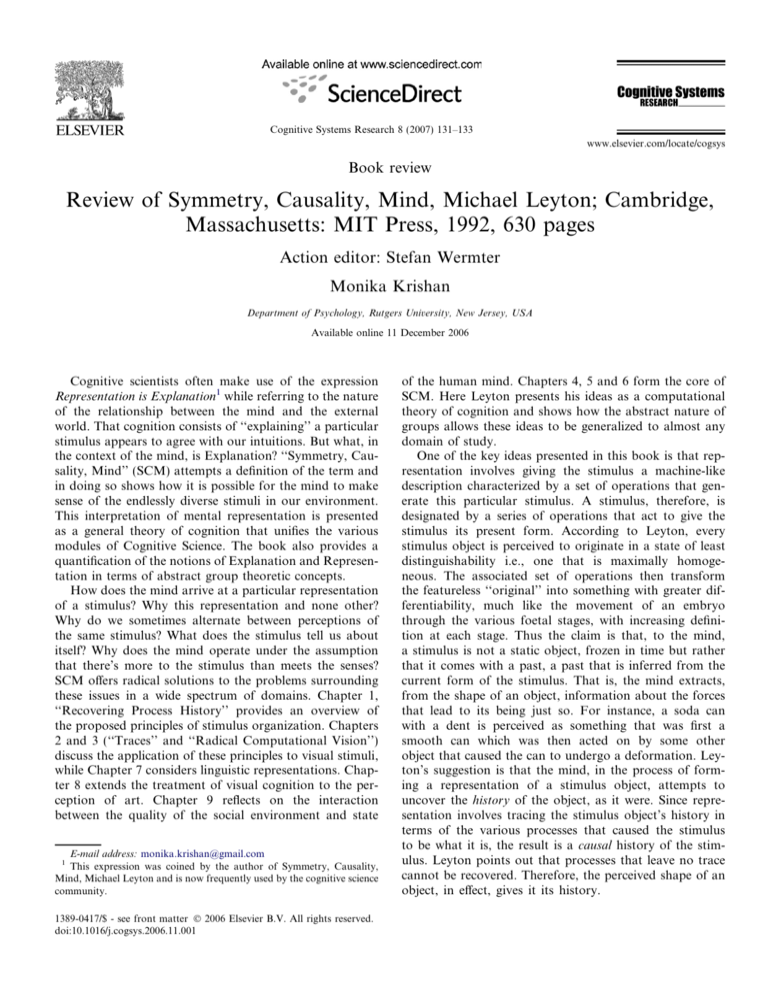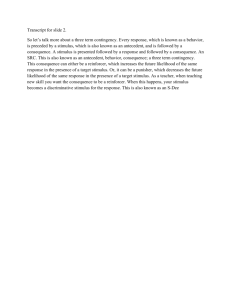
Cognitive Systems Research 8 (2007) 131–133
www.elsevier.com/locate/cogsys
Book review
Review of Symmetry, Causality, Mind, Michael Leyton; Cambridge,
Massachusetts: MIT Press, 1992, 630 pages
Action editor: Stefan Wermter
Monika Krishan
Department of Psychology, Rutgers University, New Jersey, USA
Available online 11 December 2006
Cognitive scientists often make use of the expression
Representation is Explanation1 while referring to the nature
of the relationship between the mind and the external
world. That cognition consists of ‘‘explaining’’ a particular
stimulus appears to agree with our intuitions. But what, in
the context of the mind, is Explanation? ‘‘Symmetry, Causality, Mind’’ (SCM) attempts a definition of the term and
in doing so shows how it is possible for the mind to make
sense of the endlessly diverse stimuli in our environment.
This interpretation of mental representation is presented
as a general theory of cognition that unifies the various
modules of Cognitive Science. The book also provides a
quantification of the notions of Explanation and Representation in terms of abstract group theoretic concepts.
How does the mind arrive at a particular representation
of a stimulus? Why this representation and none other?
Why do we sometimes alternate between perceptions of
the same stimulus? What does the stimulus tell us about
itself? Why does the mind operate under the assumption
that there’s more to the stimulus than meets the senses?
SCM offers radical solutions to the problems surrounding
these issues in a wide spectrum of domains. Chapter 1,
‘‘Recovering Process History’’ provides an overview of
the proposed principles of stimulus organization. Chapters
2 and 3 (‘‘Traces’’ and ‘‘Radical Computational Vision’’)
discuss the application of these principles to visual stimuli,
while Chapter 7 considers linguistic representations. Chapter 8 extends the treatment of visual cognition to the perception of art. Chapter 9 reflects on the interaction
between the quality of the social environment and state
E-mail address: monika.krishan@gmail.com
This expression was coined by the author of Symmetry, Causality,
Mind, Michael Leyton and is now frequently used by the cognitive science
community.
1
1389-0417/$ - see front matter Ó 2006 Elsevier B.V. All rights reserved.
doi:10.1016/j.cogsys.2006.11.001
of the human mind. Chapters 4, 5 and 6 form the core of
SCM. Here Leyton presents his ideas as a computational
theory of cognition and shows how the abstract nature of
groups allows these ideas to be generalized to almost any
domain of study.
One of the key ideas presented in this book is that representation involves giving the stimulus a machine-like
description characterized by a set of operations that generate this particular stimulus. A stimulus, therefore, is
designated by a series of operations that act to give the
stimulus its present form. According to Leyton, every
stimulus object is perceived to originate in a state of least
distinguishability i.e., one that is maximally homogeneous. The associated set of operations then transform
the featureless ‘‘original’’ into something with greater differentiability, much like the movement of an embryo
through the various foetal stages, with increasing definition at each stage. Thus the claim is that, to the mind,
a stimulus is not a static object, frozen in time but rather
that it comes with a past, a past that is inferred from the
current form of the stimulus. That is, the mind extracts,
from the shape of an object, information about the forces
that lead to its being just so. For instance, a soda can
with a dent is perceived as something that was first a
smooth can which was then acted on by some other
object that caused the can to undergo a deformation. Leyton’s suggestion is that the mind, in the process of forming a representation of a stimulus object, attempts to
uncover the history of the object, as it were. Since representation involves tracing the stimulus object’s history in
terms of the various processes that caused the stimulus
to be what it is, the result is a causal history of the stimulus. Leyton points out that processes that leave no trace
cannot be recovered. Therefore, the perceived shape of an
object, in effect, gives it its history.
132
Book review / Cognitive Systems Research 8 (2007) 131–133
So how does the mind accomplish the recovery of stimulus history? Leyton has put together several principles
that govern the representational process with emphasis
on their generality. These include the History Minimization
Principle which states that the representation of a stimulus
object is one that is the most concise with respect to the
number of operations required to transform the stimulus
from its initial state to its current state. In other words, this
representation corresponds to the shortest causal history of
the stimulus. Consider the example of a perfectly smooth
soda can. Although the smoothness of this soda can might
be attributable to the application of a sequence of opposite,
deforming forces, Leyton’s claim is that the mind constructs a much shorter causal history of the soda can, characterized by the absence of any kind of deformation.
Multiple representations of an object are said to arise from
multiple causal histories. For example, a metal can with its
diameter equal to its height may be seen as the result of a
rotation of a vertical line in space or as the translation of
a circle. The idea of a ‘‘minimal’’ representation has been
in existence in one form or another since the beginning of
the information processing trend in psychology. However,
the minimization referred to in the literature typically
involves a reduction in the descriptive complexity of a stimulus item. Leyton’s proposal departs from traditional Kolmogorov/Chaitin complexity in at least two ways. The
latter does not make any claim about the actual representation generated by the mind, only that it is possible to conceive of a ‘‘most-compact’’ description for a stimulus, given
a particular language of description. Further, ‘‘description’’ in the latter refers only to the current state of the
stimulus while Leyton’s ‘‘representation’’ includes references to previous states of the stimulus that may or may
not be available for inspection in the present. For instance,
Leyton’s mind would represent a rectangle not just as a
‘‘4-sided shape with opposite sides of equal length’’ but a
‘‘4-sided shape with opposite sides of equal length resulting
from a stretch operation performed on a 4-sided shape with
all sides of equal length, i.e., a square’’.
Complementing the History Minimization Principle, are
the Symmetry Principles given in SCM which further determine the recovery of causal history. Humans have always
been fascinated by the widespread existence of symmetry
in nature. The Gestaltists were some of the first to suggest
that the mind is sensitive to regularities occurring in the
environment. However Leyton proposes that symmetry
detection is not an end in itself but serves to delineate
the causal trajectory of the stimulus, in two specific ways.
In unraveling the past of a stimulus object, whether a
2-dimensional shape or a sentence, the symmetries currently present in the object are retained. Thus the ‘‘past’’
of a rectangle (a square) is chosen so as preserve the reflection symmetries that exist in the rectangle. But which of the
many pasts consistent with this symmetry preserving condition does the mind identify? The answer to this, too, is
given by the current symmetries of the stimulus, or rather
the corresponding axes of symmetry. The particular opera-
tion that takes the stimulus past into the stimulus present is
assumed to have acted along the directions of these symmetry axes. Referring to the example of the rectangle, the
direction of the stretching action that transforms the
square into the rectangle would be along the vertical/horizontal symmetry axis depending on which two of the four
sides are longer. Therefore, a square is derived from the
rectangle by (a) identifying the symmetry axes of the rectangle and (b) by performing the inverse of the stretching
operation along the appropriate axis of symmetry. Observe
that doing so leaves the symmetry present in the rectangle
intact. Thus the path from the present to the past involves
increasing the symmetry present in the stimulus by removing existing asymmetries at each stage of the process. The
recovery of causal history therefore is subject to the presence of asymmetries or inhomogeneities in the stimulus.
A perfectly symmetrical object, such as a sphere, carries
no information about its ‘‘cause’’. One could conceive of
a situation wherein the sphere originates in, say, a humanoid shape. But Leyton’s point is that the mind does not see
the sphere as such, that a backward trace involving a gradual increase in asymmetry is contrary to the mind’s design.
The claim that internal principles of organization determine causal histories which may or may not be veridical
suggests that Leyton favors the view that the mind in making sense of the world imposes structure rather than discovers it. While this claim seems reasonable it might require
qualification. For instance, it is quite conceivable that the
context surrounding the stimulus object exerts some influence on the type of causal history inferred. Further the
mind’s own history, in other words, the experience of forming causal histories in the past, might come to modulate
this process of inferring causal histories. Consider a rock
with a relatively smooth surface. The appearance of this
rock might give the impression of wear by water or perhaps
other hard objects, having originated from a state of
greater asymmetry.2 This does not necessarily contradict
SCM’s principle of symmetry preservation in going from
the object’s present to the object’s past. One could speculate that Leyton’s intention is to have the preservation
and minimization principles be applied to the entire system
consisting of the actual object, the current context and the
mind itself. However, this is a highly non trivial task and
perhaps the purpose is to motivate the reader to conduct
an exploration along these lines rather than present an
actual solution to the problem. In any event, this particular
interpretation of Leyton’s theory, if accurate, does make
the mind and the environment part of a continuum, in a
concrete sense.
Having discussed the tracing of the causal history of a
stimulus by means of its symmetries, Leyton goes on to
speculate that these very same ideas are exemplified in
2
This issue has been addressed by Michael Leyton in a subsequent book
‘‘A Generative Theory of Shape’’ (New York: Springer-Verlag, 2001).
Book review / Cognitive Systems Research 8 (2007) 131–133
the art, music and architecture that surrounds us. That is,
the principles that determine how the external world is represented also govern the creative process (see the section on
Picasso’s paintings for a rather unusual treatment of the
artist’s work). These, Leyton believes, also influence our
aesthetic preferences. Certain stimuli are especially appealing, relative to others, because of their particular causal
histories. The latter are either too simple or too complex
and reflect the corresponding ease or difficulty associated
with generating their causal explanations. Much as love is
now merely a measure of pheromone-al activity, beauty,
SCM seems to suggest, only reflects representational effort
on the part of the beholder. Novices and experts in a
domain tend to give different representations to the same
stimuli. Given that the perceived complexity of a stimulus
is a function of its causal trace, experts and novices would
also be expected to differ in their perceived complexity and
therefore desirability of this stimulus. This, Leyton would
suggest, is what lies behind the enormous variability in
responses to art exhibits.
Symmetry, Causality, Mind makes for interesting reading. Care has been taken to avoid ambiguity and unnecessary rhetoric, features that are hard to escape when the
mind is the elusive subject of discussion. The numerous
ideas expounded are intriguing and seem promising in their
potential applicability to a wide range of phenomena. Leyton has made a serious effort to flesh out applications to
certain domains, while the exploration of many others
has been left to the reader as an exercise. However intuitively appealing, theories of the mind must eventually be
substantiated by empirical evidence. Experimental support
for various hypotheses, particularly in the area of visual
cognition, has been provided either directly by Leyton’s
own research or via re-interpretations of previously existing results. But several others await further explication
and verification. At the end of the book, the student of cognition is faced with a decision – to expand on Leyton’s
work or to attempt a completely different story of the mind.
Each choice comes with its pitfalls. The former, however
tempting, could lead to a dead end while the latter could
result in the reinvention of the wheel.
An original piece of work such as this, especially one
that attempts an explanation of everything stands in danger of being completely ignored. SCM, since it first
appeared in 1992, has contributed significantly to fields
as diverse as aeronautical engineering, computer-aided
design (CAD), control theory, meteorology, linguistics,
music, neuronal growth models, robotics and even com-
133
puter vision. However there have been few, if any,
attempts to apply the ideas put forth in SCM to the study
of cognition. This is especially intriguing as SCM was
written with a Cognitive Science (CogSci) audience in
mind. Although one might speculate that SCM may have
been ‘‘ahead of its time’’, the CogSci tradition of borrowing from disciplines such as Logic, Information Theory,
Probability Theory and Graph Theory rules out this possibility. Whatever the cause of the anomaly, SCM has
much to offer in the way of a theory of mental organization. CogSci as a field is largely characterized by the particular phenomena discovered during the course of
empirical investigation. This is rather like characterizing
Gravitational Physics as the study of ‘‘falling objects’’
or the study of ‘‘tides’’. While the above may have been
a necessary step in the evolution of Physics as a well as
CogSci, the ideas in SCM are rich enough to motivate a
more ‘‘top down’’ approach to the field, grouping phenomena by the organizational principles they reflect
rather than the particular kinds of stimuli used in experimental tasks. For instance the concept of ‘‘symmetry’’
in its most general form may be used to discover the subjective differences in the way experts and novices represent
stimuli belonging to a particular domain.
Consider the domain of Chess, and the ability of expert
chess players to recall chess patterns far more accurately
than novices. One could ask questions such as ‘‘What are
the symmetries that the expert has extracted over time?’’,
‘‘How does the expert make use of these symmetries to represent chess patterns, i.e., recover their causal history?’’,
‘‘Does this explain the experts’ superior recall?’’, ‘‘Is it possible to ‘‘recall’’ a stimulus pattern without being aware of
the symmetries of the corresponding domain?’’ and so on.
Indeed SCM does seem to suggest that what the novice perceives as ‘‘noise’’ may, to the expert, appear to reflect a
high degree of order. Infants’ preference for regular polygons could be explained by the innate availability of simple
2-dimensional symmetries and the resulting ease of representation afforded by these symmetries. The enormous versatility of SCM makes it an invaluable resource for
researchers in all areas of Cognitive Science. While the
application of the notion of ‘‘symmetry’’ to a domain such
as ‘‘plan recognition’’ may not be straightforward, it is by
no means an insurmountable task and the benefits of such
a course of study are likely to be great. The reader would
do well to pick up a copy of Symmetry, Causality, Mind,
for its scope is really only limited by the use to which it
is put.








